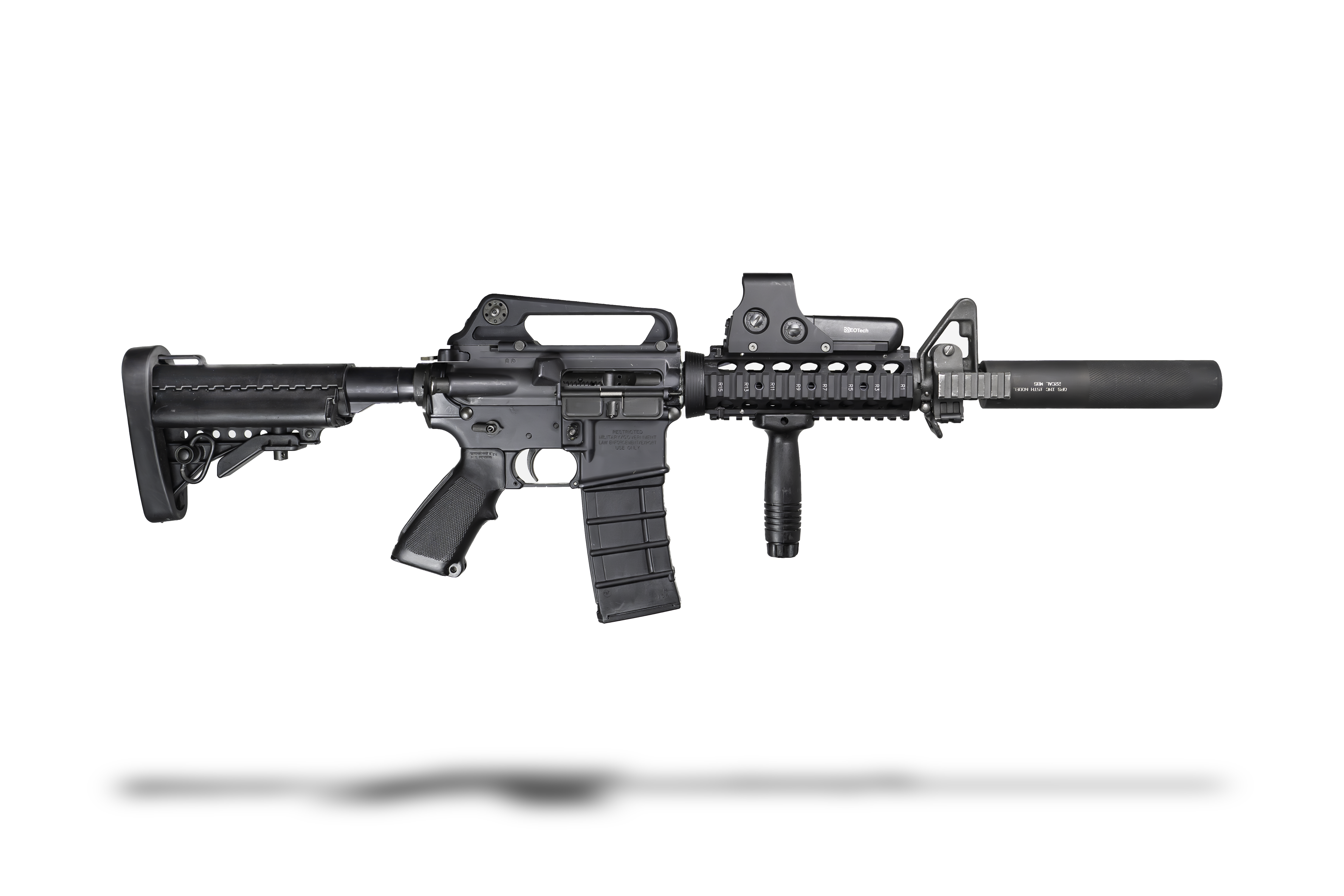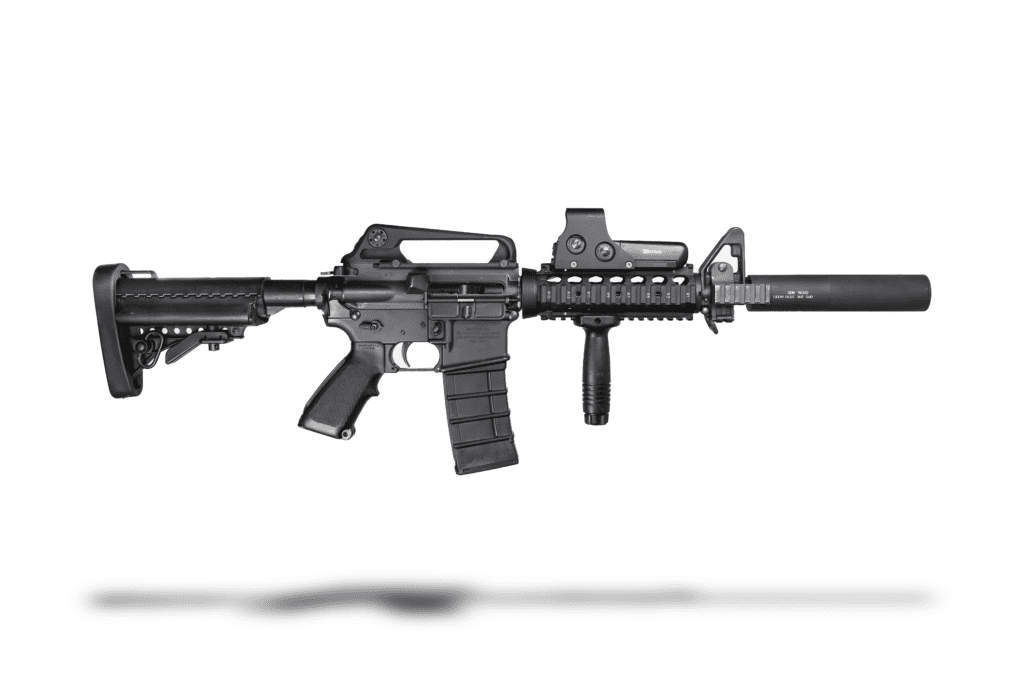
We recently received a cool rifle from Sleipnir The Horse and I wanted to go over it with yall. I just want to preface this by saying not much is known about the CanSOF rifles. The Canadian special forces were pretty good at keeping their weapon platforms relatively secret. What we do know about them comes from a few photos that have gotten out into circulation.
The one thing we can talk about with confidence is the suppressor and mounting system since OPS INC/Allen Engineering were the ones who made them. The suppressor the CanSOF units used was the OPS INC 15th model (or what is now the Allen Engineering AEM3). A few hundred of these suppressors were sold to the Canadian government. While we wont go into much detail about the contract, I will say that the purpose behind the AEM3 was to have a short suppressor that could fit over an 11.5″ barrel without adding much length to the system. That’s where the OPS/AE reflex design comes into play. Our design allowed the weapon to have an 11.5″ barrel (which helps with velocity) while feeling like a 10.3″ barrel (which helps with weapon handling in CQB environments). This was pretty much the only instance when OPS INC suppressors were sold to a foreign military.
If you remove the suppressor you will see a Smith Enterprise Vortex flash hider. The idea behind this decision was that the Canadians did not want to sacrifice on flash suppression if they were to remove their suppressor. So while the flash hider does not sound as good when paired with the AEM3, it performs much better with flash suppression than the OPS brake.
Further down the barrel is the CanSOF short collar. Many people will see the mount and assume it is one piece with the flash hider, but in fact they are two separate pieces. The collar sleeves over a .615″ barrel and is secured against the FSB when the flash hider is installed. The collar actually extends slightly past the shoulder of the barrel creating a new surface for the flash hider to push up against. It is important to note that this only works with the removal of the bayonet lug from the FSB.
Around the FSB is the Diemaco tri-rail which is clamped onto the barrel. Before you ask where you can get one, Diemaco does not make them anymore so the only way to buy one is on the second hand market. There are replicas made by BCM and others that make tracking a tri-rail down a little easier. This tri-rail was designed to extend the ability to mount a flashlight or peq further than what was traditionally capable from FSB rifles.
I will mention here that most of the parts on these rifles are Diemaco aka Colt Canada. This was a manufacturer of M4s in Canada which made many of their parts hard to find in the US due to export restrictions. This is one of the reasons this build is so great.
The handguard is a KAC Canadian Contract RAS with the KAC broomstick. The difference between a normal RAS and the Canadian contract is the fact the bottom rail has a clamping screw like the top rail. This was made to ensure a solid lockup for things like lasers or NV devices. What makes this setup peculiar is the Eotech optic pushed out forward onto the handguard. This isn’t uncommon for the time, but we have moved past that as an industry. This is funny since the build had a detachable carry handle making it confusing why the optic was not on the upper receiver. Although the carry handle acts as a rear iron sight allowing the user to co-witness their irons through the optic.
The lower is a made in Canada LE/MIL restricted Colt lower which is as close as anyone’s going to get. These were imported directly from Colt Canada as complete rifles to law enforcement agencies due to the current importation laws in the US. Colt US was unable to take possession of these rifles and sell directly to law enforcement. The original lower would have been a Diemaco “Maple Leaf” lower. Since those are serialized items and Canada typically destroys all old surplus, they were subjected to much harsher import/export restrictions.
Atop the Diemaco upper is a C7 style detachable carry handle. This is unique since pretty much all the US manufactured detachable carry handles are going to be the A2 style. This also goes ties back to Diemaco never adopting the A2 rear sighting system for their carry handle uppers either.
The upper uses an very cool charging handle. These were made a bit before aftermarket ambidextrous charging handles became a thing. It features an extended lever on the left-hand side which made it easier for the user to charge it. The leaver extends onto the right-hand side which would allow the user to depress the lever with their thumb and charge it. This could be added onto any milspec charging handle.
And finally there is a unique buffer tube and castle nut. The buffer tube has a step right before the castle nut which is unique to Diemaco. The castle nut requires the use of a spanner wrench making it also very unique for the time. I know I didn’t cover every aspect of this rifle, but I just wanted to focus on its unique aspects. For the build list please visit the build page.

